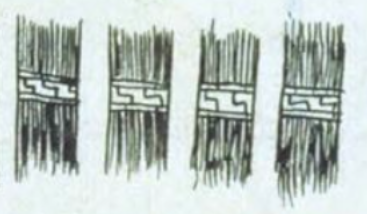nauhtzontli (Chav1)
This notation-glyph shows a frontal view of four bundles of sticks, grass blades, or hairs, each one called a tzontli, and each one is worth a count of 400. The bundles are vertical. They are wrapped with a band of white with a stepped design. Given that there are four tzontli (nauhtzontli), this represents 1,600 (a subtotal or part of a much larger count referring to pesos). (See the text in the contextualizing image, below, and/or go to the original page.
Stephanie Wood
nauhtzōtli.
nauhtzontli
Stephanie Wood
1578
Jeff Haskett-Wood
cuatro tzontles, palos, pelos, hierbas, números

nauh, https://nahuatl.wired-humanities.org/content/nauh
tzon(tli), hair, https://nahuatl.wired-humanities.org/content/tzontli
-tzon(tli), when preceded by a number, multiples of four hundred, https://nahuatl.wired-humanities.org/content/tzontli-0
mil seiscientos, 1600
Stephanie Wood
The Codex Chavero of Huexotzinco (or Códice Chavero de Huexotzinco), https://www.loc.gov/resource/gdcwdl.wdl_03246_001/?sp=1
The Codex Chavero of Huexotzinco (or Códice Chavero de Huexotzinco) is held by the Instituto Nacional de Antropología e Historia, México. It is published online by the World Digital Library and the Library of Congress, which is “unaware of any copyright or other restrictions in the World Digital Library Collection.”





